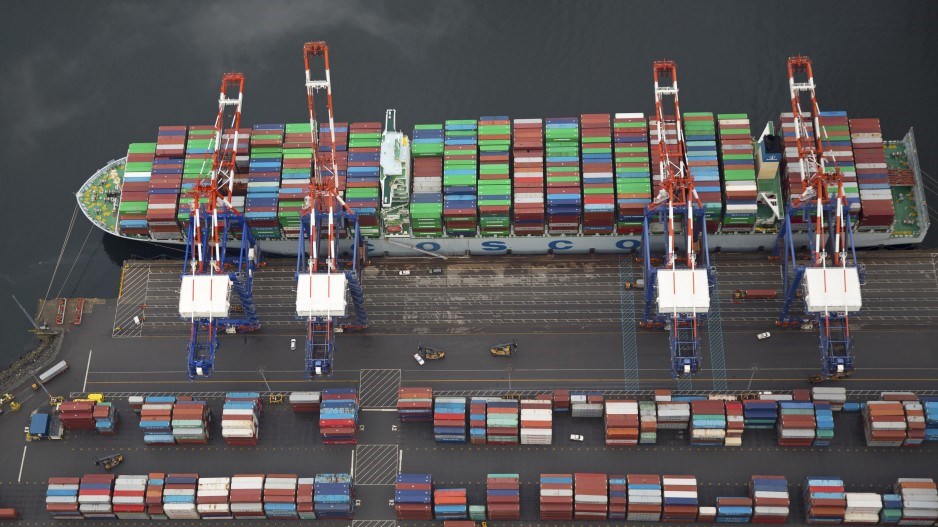No liquefied natural gas; lots of cargo containers.
That’s Prince Rupert’s post-Petronas script in the wake of the oil and gas multinational’s July 25 decision to pull the plug on its $36 billion Pacific NorthWest LNG project.
And for the Port of Prince Rupert, the cargo container narrative is an upbeat story. Today [August 29], it helped DP World’s Fairview Container Terminal celebrate the completion of a two-year, $200 million project to expand its annual container handling capacity to 1.35 million 20-foot equivalent units (TEUs) from 776,412. The project, which added three Malacca-max cranes to Fairview’s operation, allows the terminal to handle the largest container cargo vessels being deployed in major freighter fleets.
The investment from Fairview majority owner DP World is part of the Dubai-based company’s ambitious global expansion plans. It’s also confirmation of its confidence in Prince Rupert’s potential as a major destination for transpacific container cargo exports and imports and a full-service North American logistics hub, despite mixed outlooks for the global container shipping sector and steadily rising competition for West Coast North America ports from their Gulf Coast and Eastern Seaboard counterparts.
DP World’s CEO, Sultan Ahmed Bin Sulayem, told the crowd of local and international shipping and transportation attendees that his company’s investment in Fairview’s Phase 2 North expansion is in part a bet on the future of Prince Rupert as a key trade enabler for North America.
“Prince Rupert is like Dubai,” he said, “a place where dreams become reality.”
One of those dreams realized will be the addition of a new refrigerated container cargo service that will open a northern B.C. cargo container conduit for B.C. seafood and aquaculture products to Asia Pacific markets, a service that is scheduled to begin this month.
Other speakers applauded DP World’s Fairview Phase 2 investment as integral to helping revitalize Prince Rupert's port and economy.
As Port of Prince Rupert CEO Don Krusel pointed out, 10 years ago, with pulp mill closures, declining fish populations and a breakbulk facility that had lost most of its lumber and agricultural products traffic, the port was “on its economic knees.”
His vision for creating a cargo container terminal at a depressed northern B.C. port was gamble that has paid dividends far beyond Fairview, which was the first dedicated intermodal (ship to rail) container terminal in North America when it began operation in 2007. Since then it has established Prince Rupert as one the continent’s fastest growing container cargo ports. In 2007, it handled just over 16,000 TEUs; in 2016 it handled close to 737,000.
In its recently released analysis of port industrial space and freight flow through major North American trade gateways, Jones Lang LaSalle (NYSE:JLL) identifies Prince Rupert as one of its ports to watch. Also on that list: Mexico’s ports of Altamira, Lazaro Cardenas, Manzanillo and Veracruz, along with the ports of New Orleans and Everglades.
Fairview and the rest of the port are also major employers who pay out an estimated $200 million annually in direct wages and salaries. Virtually all of those employees are drawn from the Prince Rupert area. A significant number are First Nations members. Between 40% and 50% of the longshore positions are First Nations and 20% are female.
DP World has ambitions to increase its West Coast Canada cargo handling capacity to four million TEUs by 2022. Sixty per cent of that total would go through Prince Rupert as part of a third Fairview expansion that would raise its capacity to between two million and 2.5 million TEUs.
Both John Helin, Lax Kw’alaams band council mayor, and Harold Leighton, Metlakatla governing council chief, emphasized that neither are against development, only that any development needs to be done in a way that respects the environment and the area’s rich heritage of land, water and resources.
DP World, which has 78 container terminals in 40 countries around the world, handled approximately 64 million TEUs in 2016. In the first six months of 2017, it posted revenue of US$2.3 billion, a 9.6% increase over the first six months of 2016.
Its investment in Fairview’s expansion comes from the $5 billion funding pool it created last December in its partnership with Caisse de dépôt et placement du Québec (CDPQ), Canada’s second largest pension fund manager. DP World originally acquired Fairview from Deutsche Bank (NYSE:DB) in April 2015 for $580 million.
It also plans to invest $350 million in expanding its Centerm container terminal in Burrard Inlet to expand its annual capacity to 1.5 million TEUs from the current 900,000. In the first six months of 2017, it invested US$595 million in assorted growth markets.
Despite the Fairview expansions, Prince Rupert remains a relatively small player in a US$4 trillion global container cargo trade, where ports like Shanghai handle 37 million TEUs annually, and the ports of Los Angeles and Long Beach combined handled 15.7 million in 2016.
JLL’s 2017 Port, Airport and Global Infrastructure seaport outlook report also points out that West Coast ports have posted the slowest growth rate in North America since 2013. Growth at Long Beach, Seattle-Tacoma, Vancouver and Oakland, it noted, has remained under 5%, while southeastern and mid-Atlantic ports all grew by close to 20%.
@timothyrenshaw




